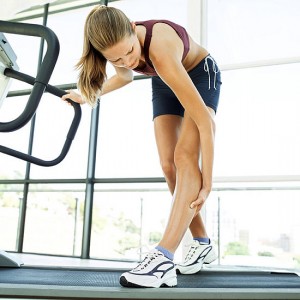Shin splints is a common concern that is super annoying to the sufferer.
So what are shin splints?
Shin splints is a common term for medial tibial stress syndrome. It refers to tissue injury and inflammation to the connective tissue and muscles attached to your shin bone (which controls the rolling of the foot). Shin splints is very common in runners due to the repetitive pounding.
Pain usually develops down the length of the inside of the shin bone (tibia front of lower leg, running from knee to ankle) during exercise and then ceases when you stop. Because the pain is sometimes mild and always ceases afterwards, people continue training over and over. However as the injury progresses, the pain intensifies and can cause the person to stop the activity. If the problem is not addressed early or the pain gets worse or continues for hours after exercising or causing aching at night, the inflammation and damage can become so severe it causes stress fractures (which would require months of rest – no thank you!)
Why do they occur?
There are several reasons for why shin splints can occur. these range from landing heavily oin the heel, tight calf muscles, being overweight, poor lumbo-pelvic stability and also weak gluteal muscles.
The main reason however is foot biomechanics according to physiotherapist Tim Keely. “As the heel hits the ground during the foot strike you are supposed to land on the outside of your heel and then roll inwards. Then during mid-stance phase, you should roll back outwards and put the weight through the outside of the foot. After which you should push off through the toes.”
“However, people suffering from shin splints, the person most often rolls the heel inwards too much, then during mid stance phase, the front part of the foot drops down and the arch collapses. The body is then unable to hold the foot in a dynamicaly good position during landing or when pushing off onto next step.”
Another factor that can cause shin splints is over-training, where the person is doing too much running without enough rest. This is most common in runners who are increasing their distance and training, their body and muscles just aren’t conditioned for it.
It is very important to make sure you have the right shoes. This includes support, shape and structure suitable for the amount and type of exercise you are doing. Keep in mind also that shoes need to be replaced, they get worn out especially if you are training a lot and should be replaced mroe frequently.
How can you treat shin splints?
Firstly I would recommend seeing a physio* so they can diagnose the problem, find the cause and provide treatment for the injury. Treatment can include:
- deep tissue massage
- dry needling
- kinesio-taping
Stretching the calves will help as well as strengthening the gluteal muscles. If you think you have shin splints, do the check list
- give yourself apropriate rest from training
- stretch your calves multiple times every day
- run on soft surfaces whenever possible i.e grass or sand
- ensure you are doing strength work for your legs as well as running to keep them in condition.
- if pain is consistant don’t wait and make it worse get yourself checked out at a physio
*when choosing a physio check out their specialities (i.e sports physio) and insist on getting assessed. A good physio will always do an assessment on you. You don’t need a bandaid for your problem you need to find the source and get apropriate treatment.
If you think someone else would benefit from reading this post, please share the love by using the sharing buttons below! 🙂
(image courtesy of fitnessinformation.net)
